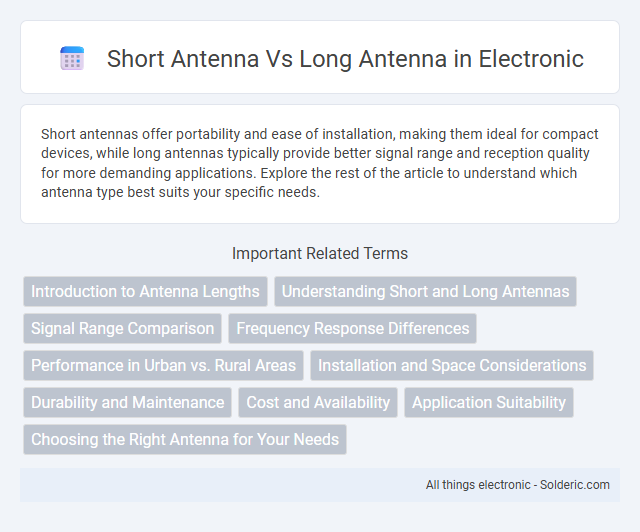Short antennas offer portability and ease of installation, making them ideal for compact devices, while long antennas typically provide better signal range and reception quality for more demanding applications. Explore the rest of the article to understand which antenna type best suits your specific needs.
Comparison Table
| Feature | Short Antenna | Long Antenna |
|---|---|---|
| Size | Compact, easy to install | Large, requires more space |
| Signal Range | Limited range, suitable for urban use | Extended range, ideal for rural or long-distance |
| Frequency Support | Optimized for higher frequencies | Better performance on lower frequencies |
| Durability | Less durable, prone to damage | More robust, withstands harsh weather |
| Installation | Simple, lightweight | Complex, requires sturdy mounting |
| Cost | Generally lower | Typically higher |
Introduction to Antenna Lengths
Antenna length significantly impacts signal reception and transmission quality, with short antennas offering portability and ease of installation, while long antennas provide better range and sensitivity. Frequency wavelength determines the ideal antenna length, typically a fraction such as a quarter or half of the signal wavelength to optimize performance. Understanding the trade-offs between short and long antennas helps you select the right design for your specific communication needs.
Understanding Short and Long Antennas
Short antennas offer compact size and easier installation, but typically suffer from reduced efficiency and limited range compared to long antennas. Long antennas provide better signal reception and transmission due to their greater length, which aligns more closely with the wavelength of the operating frequency, enhancing performance. Selecting the appropriate antenna type depends on specific requirements such as space constraints, frequency range, and desired communication distance.
Signal Range Comparison
Short antennas generally have a limited signal range due to their reduced length, which restricts their ability to efficiently transmit and receive radio waves. Long antennas provide an extended signal range as their greater length enables better propagation and reception of signals over larger distances. Signal range performance depends on factors such as frequency, antenna design, and environmental conditions, with long antennas typically outperforming short antennas in coverage area.
Frequency Response Differences
Short antennas typically exhibit a narrower frequency response, limiting their effectiveness to higher frequencies and resulting in reduced signal reception at lower frequencies. In contrast, long antennas provide a broader frequency response, enabling superior performance across a wider range of frequencies, including lower bands. Optimizing Your antenna choice according to frequency needs ensures better signal quality and communication efficiency.
Performance in Urban vs. Rural Areas
Short antennas typically perform better in urban areas due to their ability to handle multipath propagation and signal reflections caused by buildings. Long antennas are more efficient in rural areas, providing greater range and stronger signal penetration across open spaces and minimal obstructions. Urban environments benefit from compact antennas that optimize signal reception amidst interference, while rural settings rely on longer antennas for extended coverage and higher signal strength.
Installation and Space Considerations
Short antennas require less installation space, making them ideal for compact areas where mounting options are limited, such as urban rooftops or vehicles. Long antennas demand more room and sturdy supports for proper installation, often suited for open spaces with fewer obstructions. Choosing between short and long antennas hinges on available space, ease of installation, and structural constraints.
Durability and Maintenance
Short antennas generally offer greater durability due to their compact design and resistance to wind damage and bending, making them less prone to physical wear and tear. Long antennas require more frequent maintenance as their extended length increases vulnerability to environmental factors such as corrosion, physical stress, and alignment issues. Proper material selection and regular inspection are crucial for maintaining the performance and lifespan of longer antenna systems.
Cost and Availability
Short antennas generally incur lower costs due to reduced material use and simpler manufacturing processes, making them widely available in most retail and online stores. Long antennas tend to be more expensive because of higher material demands and specialized designs, but they are often found through specialized suppliers and professional retailers. Your choice between the two will impact budget and accessibility depending on the specific communication needs and device compatibility.
Application Suitability
Short antennas excel in compact devices and urban settings where space is limited, making them ideal for portable electronics and IoT gadgets. Long antennas provide superior range and signal strength, suited for rural areas, long-distance communication, and applications requiring enhanced reception. Your choice depends on balancing size constraints and performance needs for optimal application suitability.
Choosing the Right Antenna for Your Needs
Selecting the right antenna depends on frequency range, installation space, and signal strength requirements; short antennas offer compactness and ease of installation but typically support limited range and bandwidth. Long antennas provide enhanced signal reception and transmission over greater distances, making them ideal for high-frequency or low-signal environments. Consider device compatibility, environmental factors, and performance needs to determine whether a short or long antenna will optimize connectivity and overall system efficiency.
short antenna vs long antenna Infographic

 solderic.com
solderic.com